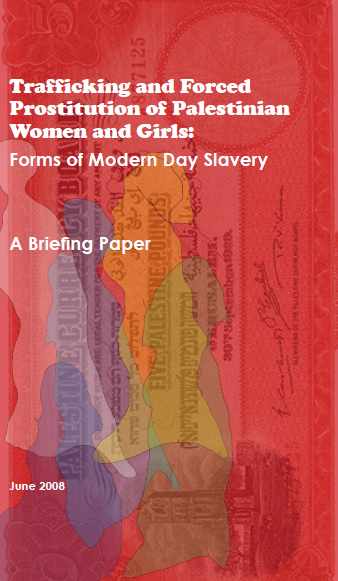
Trafficking and Forced Prostitution of Palestinian Women and Girls: Forms of Modern Day Slavery
Auteurs : Sawa-All the Women Together Today and Tomorrow
This report seeks to explore the issue of trafficking as well as prostitution of women and girls in the occupied Palestinian territory (oPt). Due to the absence of accurate information, studies and official reports openly dealing with the topic, this briefing paper intents by no means to present itself as a comprehensive study but, rather, as a first step towards the identification of the problem in the oPt. A great deal still remains to be done even in the area of basic research and documentation.
This paper is divided into eleven main parts. Part One provides a description of the research objectives, the methodology employed, the selection of key informants for interviews and the challenges faced by the research team. Part Two outlines the geopolitical context of the oPt. Part Three depicts briefly the problem of women trafficking and sexual exploitation in the oPt.
Mapping prostitution and trafficking movement into and out of the oPt was further presented in Part Four. This part outlays how trafficking occurs and presents a better understanding of transnational and domestic trafficking within the oPt and into Israel. In this section, it was attempted to map this movement based only on the cases identified by the research team.
Part Five presents information on the background of women forced into prostitution as identified by the interviews with lawyers, police officers and pimps. To combat trafficking and sexual exploitation, it is essential to know who the women are, where they come from. To understand the operation of trafficking and sexual exploitation, it is important to know if women have been sexually exploited before entering into prostitution and at what age. Knowledge of women’s educational, social and economical background is crucial to providing assistance to victims. Within the same concept, causes of trafficking and prostitution were also presented in Part Six.
Part Seven provides the profile of traffickers as identified by the case studies. Case studies of traffickers and the trafficked were tackled in Part Eight and Nine. In addition, the issue of human trafficking for the purpose of prostitution was tackled from a legal aspect based on the Palestinian and Israeli legislations and societal practices in Part Ten.
Finally, based on the analysis of the root causes that make Palestinian women vulnerable to sex trafficking and the factors that contribute to their ongoing sexual exploitation, policy recommendations were presented in Part Eleven.
Thématiques
- Monitoring et évaluation des politiques publiques sur la traite
- Stratégies et plans d’action
- Genre et vulnérabilité
- Traite des femmes et des filles
- Violence basée sur le genre
- Récolter des données sur la traite
Population Ciblée
- Grand public
- Professionnels en lien avec la lutte contre la traite
Type d’exploitation
- Esclavage ou les pratiques analogues à l’esclavage
- Exploitation de la prostitution d’autrui ou d’autres formes d’exploitation sexuelle
Focus géographique
- Israël
- Moyen-Orient
- Palestine

